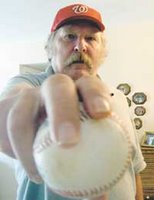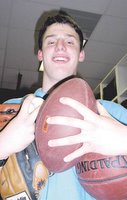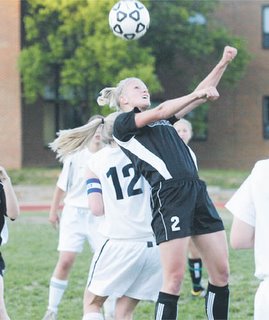Girls basketball has gone from forgotten sideshow to unforgettable pastime.
By BJ Koubaroulis
December 8, 2006
Had they played 20 years ago, Lauren Reinshuttle knows that she and this year’s class of high profile Div. I girls basketball recruits, might not have been playing at all. “My parents always tell me that if you played basketball 20 years ago,” Reinshuttle, a South County Secondary senior who committed to Duquesne, begins to explain. “That you wouldn’t be playing basketball 20 years ago.” This year’s class of high profile seniors, which includes Reinshuttle; Oakton preseason All-American Jasmine Thomas (Duke); Doreena Campbell (UCLA), a guard who led Edison to the AAA state final last season; and South County’s Laren Robinson (St. Joe‘s), represents one of the strongest recruiting classes of girls to emerge from the Northern Region. Several factors, including the introduction of the Amateur Athletic Union, enforcement of Title XI, rule changes, media exposure, coaching and the physical attributes and growth of women over the last three decades, have helped the sport’s progress. “Point guards are now six feet,” said Langley head coach Cheryl Buffo. “It was tough to find a post player that was six feet 20 years ago. They are bigger, they are stronger and they are playing year-round. They are in the weight room.” Reinshuttle, Thomas, Robinson and Campbell are proof that the girls game, once tucked into after school time slots as a club sport, in a gym made available only when the boys were done with it, is “revolutionizing,” said Campbell.Campbell's Edison squad enters the season ranked sixth in the country by USATODAY and, according to Edison coach Dianne Lewis, seven of her players are receiving serious collegiate offers. “[Girls] are not playing above the rim like the guys, but they are certainly playing at the rim,” said Lewis, a 1977 T.C. Williams graduate. “When I played back then, you had your athletic teams and fundamental teams. Now, you have fundamental teams that are athletic. That combination can be pretty lethal.” Three area AAU teams finished ranked in the top 16 in the nation this past season. “The opportunities are there,” said Oakton coach Fred Priester. “It’s all about opportunities.”
“You’ll practice when the boys are done.”
Laura Beaver, who is now a Physical Education teacher at Centreville High School and the Commissioner for the Metropolitan Field Hockey Association, coached at Herndon High School for 22 years in the late 1970‘s. She’s what Priester called one of the early pioneers, one who had to fight for opportunities. “We fought those battles,” said Beaver, a 1971 Woodson graduate. “You’ll practice when the boys are done,” she was often told when she coached at Herndon. “We were fortunate enough to win a couple of district titles, so after a while we’d ask the boys, where’s your banner?” During Beaver’s playing days, girls basketball was still played with a regular sized men’s basketball. There was no 3-point line, and contrary to the boys 5-on-5 game, girls played 4-on-4 — a style which allowed each team two guards and “two rovers,” Beaver explained. “Rovers were two people on each team that could cross over the center line.” Even the amount of dribbles allotted to each player was limited. Girls games were also played after school at 4 p.m. in contrast to the prime time night games the boys played. Westfield coach Pat Deegan coached Madison to six regional titles and one state title (1991). “Title IX kicked open some doors,” said Deegan of the 1972 law that aimed to even the playing field between boys and girls. “Interest follows money and when girls basketball programs at the college level were fully funded, that is the kind of thing that just elicits interest.” Priester noted that WNBA games and televised college games, as well as the increase in media coverage of women‘s sports, has pushed the game to a new level. “It wasn’t long ago where they were lucky to get the scores listed [in the newspaper],” said Priester.
“There’s some girls we need to look at in this area.”
Larry Hubbard, in his 19th year as an assistant coach at Madison, helped create the local girls Amateur Athletic Union circuit (AAU) when he and a few area coaches started the Vogues — a program that began with one group of 14-year-olds and has since sprouted into 29 teams with multiple levels of participation, with age groups from 9-18. Hubbard, with Bob Schule, Tommy Orndorff and Judy Bageant, helped catapult the Potomac Valley District into an AAU circuit spanning Prince George County, Montgomery County and Fairfax County. “We had girls traveling from Maryland to try out,” said Hubbard of his first organized tryout in 1980. He estimated that there are currently nearly 150 girls AAU teams in the metro area, which includes prestigious programs like the Vogues, the Fairfax Stars, the Virginia Cardinals, the Aces, No Limits and others. Hubbard helped organize the first and only AAU National tournament in Fairfax County in 1985. Even then, it was difficult to raise support for what many saw as a dying sport. The 16U national tournament was held at Lake Braddock, Chantilly and Fairfax High Schools after Congressman Tom Davis, who was a district supervisor at the time, convinced the school board to welcome the event. “The county wanted to charge us $94 an hour for air conditioning,” remembered Hubbard. “[Davis] went to the school board and superintendent of schools. He helped us bring it here.” The tournament brought with it recruiters and college coaches who saw that “there’s some girls we need to look at in this area,” said Hubbard.
“There is no such thing as offseason.”
Christy Winters Scott brought South Lakes girls basketball its only state title. Winters Scott, who won a national title with the 12U Vogues in the AAU circuit, posted 1,785 points, 1,075 rebounds and 492 blocked shots in her high school career and helped South Lakes to a 29-0 record and state title in 1986. The 38-year-old, who was inducted into the University of Maryland’s Hall of Fame in November, now coaches the South Lakes girls basketball team after having played professionally overseas. She was one of eight players from a 16U national runner-up team to a earn Div. I scholarship in the late 1980‘s. “Over the last 15 years, the explosion has been tremendous,” said Winters Scott of the girls game. “The athleticism has tremendously improved. I don’t know if I could go out there and do anything against Jasmine Thomas. You see so many girls that are playing [in high school] now that have the college athleticism that I didn’t have in college.” Winters Scott credits the explosion to the opportunities that girls have today. “There is no such thing as offseason,“ said Winters Scott. “There is time to improve, but no time away from the game.”
“You are going to college from the time you are 10 years old.”
Thomas, who broke nearly every Oakton basketball record (boys and girls) as a junior, is a prime example of how players no longer take time away from the game. After the end of girls basketball season in March, Thomas traveled to the Nike Skills Academy — a camp that welcomes only the top 21 girls high school players in the country, 16U Nationals and Nike Nationals, and competed at the USA 18U Women’s Olympic Team trials, U.S. Junior Nationals and several camps and tournaments. That schedule left her with only two weeks off in August this entire calendar year. “I guess it’s good because you don’t really realize all the opportunities you are getting until you see some people who don’t get the same ones as you,” said Thomas, who has seen AAU teammates fall off the circuit because of lack of skill, lack of desire or lack of funds. “AAU ends in the beginning of August and then you are off, but that’s time for you to rest and recover for high school, so it’s non-stop, it’s just constant.” Campbell has played for the Virginia Cardinals AAU program for three years and keeps a similar schedule. Reinshuttle and Robinson are no different. West Springfield coach Billy Gibson has coached several Div. I recruits, including the WNBA’s Kara Lawson. Gibson knows that the promise of scholarships is what drives most players to keep such intense training schedules. “You are going to college from the time you are 10 years old,” said Robinson who trains three days a week for two hours with coach Aggie McCormick-Dix’s Faiffax Stars, an intense program which has pushed an overwhelming number of girls from this region into the collegiate ranks. “If you want to do that, if that is your goal, they are going to push you full-force.” Campbell realized her potential early.“Basketball seemed like somewhat of a ticket,” she said. “In ninth grade, I started getting letters and thinking ‘wow, I can get a scholarship.’”
“It’s gotten a little out of control.”
Many area coaches, parents and administrators believe that the offseason has created an unhealthy environment, including a schedule that could see players engaged in too many games. First year Herndon coach Reggie Barnes has done the math. “The difference between a player that does [play AAU] is over 400 hours of court time, depending on how many tournaments you are in,” said Barnes. Madison coach Denise Weinig, who is enshrined in the Madison High School Hall of Fame, took a full scholarship to play at the University of Delaware after playing on Deegan’s dominating Madison squads in the early 1990‘s. “The reason we dominated early on is because there wasn’t the parity there is now,” said Weinig. But Weinig believes that parity in the region has come at a cost to the individual. “We have about 1,700 students,” said Weinig of the Vienna-based school. “Last year there were three athletic scholarships and 150 academic.” Weinig is part of a growing belief that many girls are specializing in a chosen sport too soon and are chasing elusive athletic scholarships. “They don’t realize how difficult it is to be in that elite group,” said Weinig. “Just because you are the best in Vienna and the best in the Liberty [District] doesn’t mean anything.” With the increase in scholarships at the collegiate level, many girls have waved good-bye to the days of playing multiple sports and have begun focusing on year-round hoops. “I think it’s gotten a little out of control,” said Weinig. According to Oakton head coach Fred Priester, who started coaching with the Vogues in 1985 after taking over the varsity girls program at McLean in 1979, the numbers tell the story. “In 24 years of coaching high school basketball, I’ve coached on a varsity level, about 550 games,” said Priester, who owns a 398-156 record in those games. “I’ve coached twice as many AAU games as I have high school games in a shorter amount of time.” Priester has coached nearly 1,200 AAU games.“We are almost at a saturation point,” said Priester. “Virtually any girl that wants to play in the offseason, there is a place for them to play.” Hubbard knows that the intention of his start-up has been skewed. “In my opinion, they play too many games,” said Hubbard. “Back when I got started, we would have a local tournament and maybe go up and down the east coast once or twice.” That schedule gave his teams up to 12 off season games. “Now, they are playing 50-80 games, and I’m talking about 11-year-olds,” said Hubbard. “It’s great for them to play year-round, but I don’t want them to wear the kid out by the time she’s 14.”
Additional reporting by Paul Frommelt, Rich Sanders and John Marcario.





















